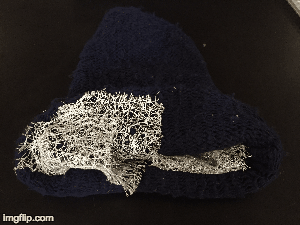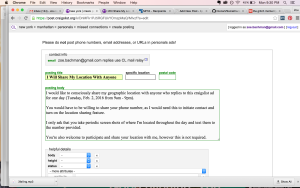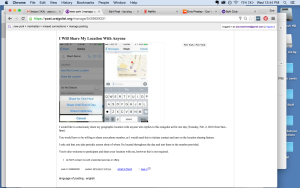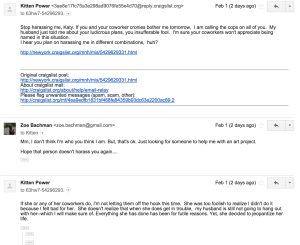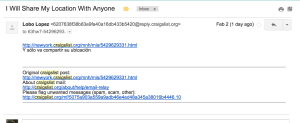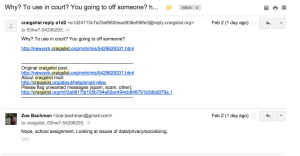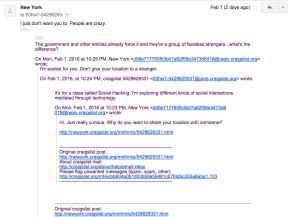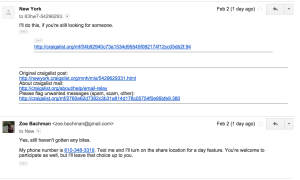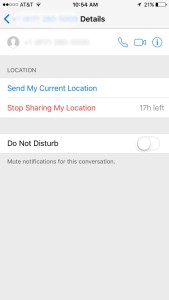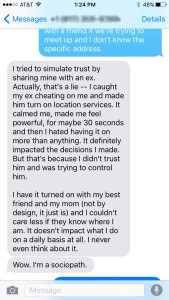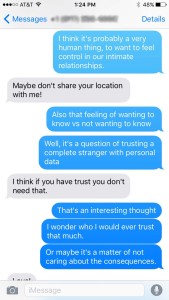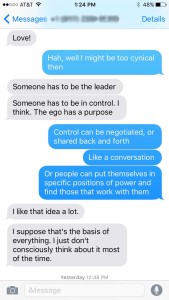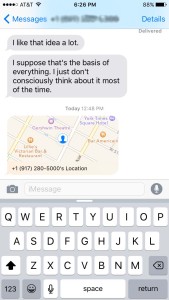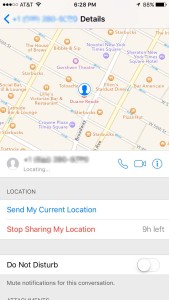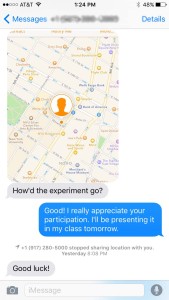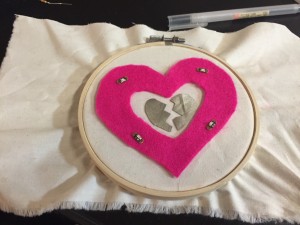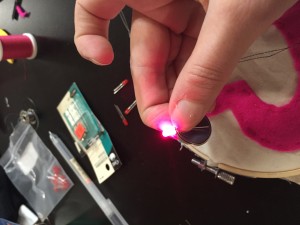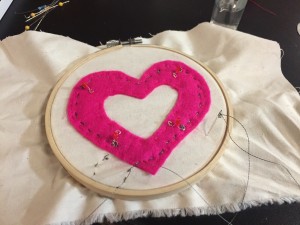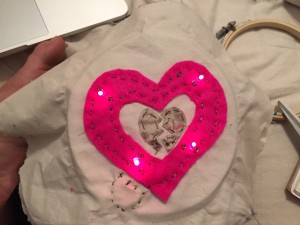RWET, Assignment 1
I’d been filing away text ideas all week long. I thought I wanted to work off of a poem, but as I was going through the python exercises I’d thought it would be more interesting to take a longer text and condense to only a few words; just use the raw language and reconfingure it. I guess that’s what the class is, right?
I love space. I thought I wanted to be an astronomer at one point. I was super psyched about the latest news proving Einstein’s theory of relativity.
I was on tumblr and kept seeing this post:
…and I started reading it like a poem.
I realized, I’ve never actually looked at the Theory of Relativity text and got curious. It’s fairly dense but had some interesting words, such as infiniteness and Euclidean. I chose to use Chapter 31: The Possibility of a “Finite” and Yet “Unbounded” Universe, which was quite poetic as it was theoretical.
For my python program I wanted to play with condensing the text in a way that would lead to unexpected contractions and creative possibilities. I recalled the example that pulled and combined the first four characters and the last four characters of a line. I played around with a few variations, settling on 10 characters from the beginning and end. The result was not only a shortened text, but actually the creation of new words in the center. Considering this came out of the discovery of how black holes merge, I thought this result was quite appropriate.
Here’s a selection of some of the lines:
In the firnal space.
Flat beingn a plane.
For them neir plane.
In particution XXIV.
In contras infinite.
….
It is finino bounds.
It may be space.”
It can be ch other).
An ellipti symmetry.
It followsnceivable.
From amongquivalent.
I like that the words sound almost like a form of Middle English, or Latin.
Doing this process reminded me of the sound glitching I’ve played around with recently, where it’s a question of restraint and simplicity. It feels counterintuitive to write a simple piece of code but have beautiful language emerge. Like more effort should have happened. Or more thought. I feel like I cheated. But I like the result.
Temp Expert, Wk 3: Readings
*Cracks knuckles*
Here we go.
I take these readings as a good sign that I’ve switched into this class. 1. I love reading 2. I love interdisciplinary exploits 3. String theory and multiple realities is hella cool
But in all seriousness.
Maybe it’s my background as an anthropologist and someone with a particular interest in critical and radical theories, but the idea of an ultimate, one-size-fits-all theory just doesn’t ring true to me (we can argue about what truth even means later). As no one person can simply have one identity to fit all contexts, why should we expect our universe to possess that quality? That’s why the M-Theory makes a ton of sense to me. We all know at this point that anything reacts differently under observation, so the fact that we can catch glimpses of certain aspects of our universe is pretty amazing. Generally, I find the tension between subjective/objective interesting and even how our experience of that has shifted over time (particularly rapidly in the 20th cent). A couple other things from the article jumped out – that we can consider M-theory as a “network of theories” (I like networks), discrete yet interconnected and making up a whole but also boundless. Also, the quote that “diversity is acceptable” since it leads back to my topic of biodiversity and asserts again that a plurality of voices/experiences/theories are what is needed to solve problems.
The Whitman reading, frankly, I didn’t care much for beyond it being a case study of interconnections between art an science. I think the author’s voice was a bit to authoritative on ideas of “what is science” vs “what is art” and what each of those stands for in our society. But maybe he speaks from a more traditional, normal standpoint and as someone who has spent time deeply considering the roles of these disciplines in society I just am used to more nuanced discussions (à la the critical design school, from what I can tell). I guess the take away was again this notion that there is no absolute truth, that as the author says in the prelude, “Neither truth alone is our solution, for our reality exists in plural.” I unfortunately just thought the final sentence, “The mind is made whole” a bit too neat and somewhat reductive. Why does a mind need to be whole? Why can’t it exist as a jumble of fragmented, networked and possibly contradictory parts?
Within the bit about Whitman himself, it was pretty incredible to read this narrative about art and science informing each other (not to mention how everyone seemed to know each other back in the 19th cent). “The Body Electric” is such a beautiful phrase and captures both the personal experience of emotion as well as a scientific fact. Truthfully, I never thought much about how the body could experience emotion before the brain does. As a woman, I couldn’t help but think about hormones, PMS and associated mood swings. At certain times in the month I experience emotions that have no basis in my daily experiences, so I chalk them up to whatever estrogen-related fluctuations are happening at the time and move on. But it is very frustrating to feel so strongly (especially when it involves other people or could affect them) and know that it’s not coming from my brain (where I feel like I have control) but my body.
Lastly, I really enjoyed the “Slow Ideas” piece, mainly because it illustrates how issues of power come to play in finding solutions and thus why its important to have many voices involved when designing and implementing such solutions to make sure stakeholder needs are met. When I finished the first section and the author was like, why didn’t antisepsis catch on as quickly? I knew why. It was a question of who did it benefit. The doctors were the ones making the decision about implementation and to them, antisepsis practices involved more care and effort on their part where as anesthesia made their lives easier. Well, the author goes on to explain that’s exactly the case.
So it makes sense that the question is not how do we work within existing cultural ideas (because in our capitalist society, these are often predicated on simply looking after oneself and doing what is profitable), but how do we change norms? And specifically what they’re looking at in terms of the birth center, how do we make people more empathetic, even if it isn’t a “scalable” (ie profitable) solution? Focusing on the long-term rather than the short-term.
And isn’t that a good metaphor for climate change? Sure, the changes that are necessary are hard to implement because of economic and lifestyle changes but the effects in the long-run are what’s important.
Temp Expert, Wk 2: Readings on Design/Thoughts on Diversity
So, I just joined the class and catching up on all the readings. I was thrilled to see we had design related reading this week because I’ve wanted to get a solid foundation in design principles. I also couldn’t be happier that the readings came from (what I assume to be) more alternative approach vs. traditional design practices.
In particular, I LOVED the “Challenge of Responsible Design” reading. The piece touched on a lot of reasons why I decided to come to ITP, particularly with regards to who gets to be involved in design processes. I have a background in community organizing and facilitating group projects, so I’m very interested in learning more about how we can bring more voices in when we design projects, objects, and systems and intentionally collaborate with end-users so their visions are supported. This is part of a deeper set of thoughts related to the lack of diversity in tech, the siloing of the tech world from its user base and the lack of access to tech education for many marginalized communities.
Speaking of diversity, I was really excited to get biodiversity as my topic because I immediately knew I could relate it to interests of mine regarding access, power structures and alternative forms of organizing. I was talking to a friend and she mentioned that Reply All recently did a podcast about diversity in tech and related it to fecal transplant studies. Let’s just say that diversity is always, in the long-run, the most beneficial situation for everyone. When it comes to problem-solving (which design is all about), more differences in background and experiences lead to more associations and more paths to finding solutions.
As I was researching biodiversity, I thought about my friend who is getting her PhD in marine biology at Northeastern, studying coral reefs in Panama. Turns out, coral reefs are considered to be one of the most biodiverse ecosystems on the planet. A couple ideas stood out to me in relation to reefs. One was that biodiverse areas are more resilient to changing conditions and can better withstand significant disturbances. Another was that coral reefs are cradles for new-life forms at various points in our planet’s history.
Still more to look at, for sure. I especially want to dig deeper into the symbiotic relationships present in biodiverse ecosystems and methods of inter-species communication (if that’s a thing?) and find ways of relating that to our own human patterns of organization.
Temp Expert, Wk 1/2: Readings on the Anthropocene
Biggest take away form the first set of readings was the economic tie-in to progressing with environmental policy changes. What seems to be holding many nations from signing agreements are fears that certain regulations and changes will affect their main industries and ways of generating capital.
One quote that I wrote down: “Where capital goes over the next fifteen-years is going to decide whether we’re actually able to address climate change and what kind of century we’re going to have.”
There’s talk of decoupling the relationship between economic growth and growing emissions, but it made me think of how conversations could be reframed in terms of how we think about capital and necessary capital – and who benefits from that capital. There’s a long history of environmentally unsound projects disproportionately affecting already vulnerable groups – trash incinerators, for example. And even if profits are generated from these ventures, they’re most likely not receiving any of it.
So, it’s interesting (and not so surprising) that Sweden is listed as an example of country that has been able to grow their wealth while cutting down on emissions.
I was also profoundly affected by the “How to Die in the Anthropocene” (NYTimes). This idea that studying philosophy is learning how to die, so how do we learn to die as a civilization? I’m curious about the idea that in accepting death we find a sense of freedom and ease with which to move about the rest of our day/lives. I just imagine that for others, thinking about death even in an intentional way would be anxiety provoking. Or provoke them to quit. What point is there in acknowledging death if it simply results in inaction?
Threw me back to when I first learned about existentialism in high school while reading Camus, The Plague. The idea that even though death was inevitable, it was important to go on about our day and create meaning out of our actions. Is Scranton taking a step further and suggesting that we should not simply just continue living day to day, but actually make some changes to our lives that would impact our environment less? Will accepting our fate make us want to work to improve our planet or will we act greedy and use what resources we have while we are still alive to reap the benefits?
Wearables, Week 2: Readings
Reading “Design For All-Life” reminded me of Rosi Braidotti’s text, The Post-Human. Moving away from human-centered thinking to considering our relationship with the rest of the world, but also acknowledging that the way we’ve often thought about the human as a white, western, able-bodied Male.

Thinking in terms of the post-human would not simply re-orient towards considering the larger biosphere but also consciously bring in oppressed and marginalized groups so often seen as subhuman/subaltern.
I find it interesting that both of the non-technical readings mentioned that humans have particular affinities, love even, for generalized categories – in “Design For All” it says for living things and in “Why The Human Body Will Be The Next Computer Interface” Fjord says humans are built to desire communion with the man-made world. Are we simply built to love everything to some extent? Or is it something to do with movement? or that the things we make are made in nature’s image and we give them life-like characteristics?
Wearables, Week 2: Forming an Idea
Ok, so
Doing a 180
I was struggling with my previous ideas…while I liked them in certain ways, nothing was really sticking. I started thinking back to other projects I’ve been working on and realized I’ve been very interested in this idea of tracking, emitting personal data, surveillance/sousveillance as well as unseen signals, waves of communication that carry voices and action. How can we disrupt and intervene?
I read this piece today on the New inquiry and one thing that resonated with me was this feeling that surveillance is so pervasive that it seems banal, that our feelings of powerlessness translate into acceptance and inactivity.
“I think most people truly expect to be anonymous in public,” Jennifer Lynch, an attorney for the Electronic Frontier Foundation, told Motherboard recently. Anonymity is a crucial element of public spaces and communication, she argues, and allows us to freely participate in a democratic society. “[When people] are being watched,” she said, “it chills their behavior—it chills who they will associate with, how they will act, and what they will say. That’s not a society I want to live in or raise my son in.” (http://motherboard.vice.com/blog/last-minute-costume-that-makes-your-face-illegible-to-computers)
Many wearables on the market today are made to track data, but what if we create a wearable that interferes with the already ubiquitous tracking that is taking place in our daily lives?
When I was researching surveillance last semester I came across Adam Harvey’s project CV Dazzle. He used make up and hair designs to disrupt facial detection software. The idea is to create an ‘anti-face’. But Harvey’s piece relies on physical choices, such as dying/cutting hair and applying make-up in specific ways. Is there something that can be taken on and off. I’d also be interested in incorporating some kind of signal jamming hardware or other disruption techniques.
I’m imagining something that can be gender-neutral, with the ability to morph in shape, so could go from something more “normal” looking to something more obviously disorienting and glitchy. I’d imagine that it would take the form of a hat, or scarf/cowl. It would need to be all-weather and fashionable so that people would be interested in wearing it at any occasion. I imagine primarily a user in an urban setting.
In terms of aesthetics I’m looking at accordion-style folded fabrics and veils. Both of these have the ability of covering and receding when necessary. I like the femininity of the veil, but I want to think more about how it can be adopted in a gender-neutral way.
Here’s my new mood board:
https://www.are.na/zoe-bachman/screwing-with-surveillance
UPDATE:
Renata just told me about the artist Ying Gao who responsive clothing pieces. This got me thinking, instead of the wearer activating the transition from being seen to being hidden, that something akin to the process in the under(a)ware -his and hers underwear designed to sense hidden Radio Frequency Identification (RFID) Tag readers and alert the wearer to their presence by activating small vibrators sewn into bras and boxer shorts in strategic locations. So, I could embed an RFID tag reader into the pieces and have them animate to hide the wearer when signals are present.
Wearables, Week 1: Mood Board
https://www.are.na/zoe-bachman/wearables-inspo
*forgot to link to my mood board last week*
I’ve been toying around with this idea of non-verbal communication via wearables since I made the Semaphore Jacket last semester. There are many ways to send messages without speaking, from visual displays, written text, morse code, gestures…I started looking into EEG brain waves and RFID capabilities.
Part of me wants to continue working and improving the Semaphore Jacket. When I presented it at the show, a lot of people anticipated that it had the ability to transmit text messages or computer-readable messages. I talked to someone involved in wearables if it would be possible to do some kind of machine-learning to remember specific gestures and assign them a letter, so that you could spell out messages and have a computer translate them and potentially send them out over the air.
When I was throwing around ideas, I recalled my attraction to embroidery as an art form. I’ve always admired embroidered pieces and their history as a female art form. I went to Budapest a few years back and one of my favorite memories was going to the Ethnographic Museum and seeing the displays of traditional costumes. The embroidered patterns were so intricate yet consistent in certain ways. Looking into them, particular the cross-stitch, I wondered if there could be a way to correlate those patterns with binary and transform an art form into a communication method. Recently re-found an article about hungarian embroidery patterns turned into punch cards to make music!
Social Hacking, Week 1: I Will Give Anyone My Location
For our first week, we had to reinterpret Steve Lambert’s “I Will Talk With Anyone” with our own personal flavor.
I found this assignment very interesting 1. Because Steve Lambert is a well-known social practice artist and that’s something I always dig 2. Because in reality, Steve’s piece is very specific.
What I mean is, in trying to recreate or do a variation on the piece, what aspects do we choose to preserve and which do we choose to alter? And what effect do these changes have on the concept and essence of a piece?
There is a beautiful simplicity and specificity to the original. What more pure social interaction is there beyond a conversation? About anything?
And then there’s the specific context of the original piece. Playing off of a tradition of setting up tables in a public space (what we called ‘tabling’ in college), Steve uses a social situation that many are familiar with but instead of forcing others into having a conversation, he invites them in. Even better, that person gets to choose what they want to talk about, rather than be forced into a conversation about religion or war, etc. He intentionally uses visuals and context to provide a familiar and seemingly easier environment. It’s actually pretty amazing to think about what the piece did – he managed to create an opportunity for social interaction with a stranger that some how seemed less threatening than its initial context.
I had a hard time coming up with an idea I liked. I tried thinking about the basic ideas behind the project: exchange/barter, interaction, intimacy/vulnerability.
What ended up interesting me most was the idea of generating intimacy with someone unknown and creating feelings of vulnerability. Part of me wanted to move beyond the conversation as exchange and imagine another type of exchange – perhaps one that did not hold the same kind of balance as a conversation and specifically made me the vulnerable person. Because in our reality, how often are interactions and social relationships actually equal?
I chose to share my location for a day with a stranger and invite them to reciprocate.
While Lambert’s piece takes place in a public space, I wanted to acknowledge how many human interactions are now unseen. When we perform actions online, we sometimes forget about the other humans on the other side who see their results. Faceless workers at Apple, Google and the NSA look at our data, but they’re still individuals with wants/needs/lives processing/review our personal information. What difference is there between a paid facebook employee reviewing posts and giving access to another faceless stranger?
This piece is a conscious coupling with unknowable consequences.
Where does the power and control lie? In the person designing the interaction or the person agreeing to observe?
I decided that I would use Craigslist to put my message out into the public sphere and invite strangers to participate. At first, I couldn’t decide what category would make it most visible. I first went for the community-volunteers section because contextually that seemed the best fit. But then I thought about where people actually live on Craigslist and posted it again under Missed Connections. My thought behind the choice was that people look at Missed connections because they hope that someone is searching for them, which essentially was what I was doing.
About half an hour later I got my first email.
and some others…
My most significant interaction came from a person who used the handle “New York”. They were curious about the project, but also very concerned for my personal safety.
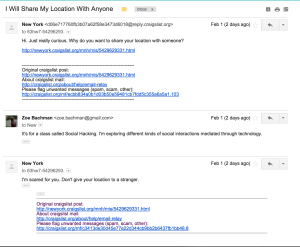
This and the Kitten Power emails brought up the underlying question of mental illness. It seemed that people on Craigslist were divided between assuming that I’m crazy and trying to harass them or that other crazy people will harass me.
I was preparing to execute my plan B idea, but then New York offered to participate if no one else did (no one else did, or has).
I gave them my phone number and turned location services on.
Honestly, I thought that would be it. I mean, besides receiving screenshots.
Instead, the person started asking me questions about the project and we got into a full blown discussion about relationships, power and control

For someone who had warned me against doing this with other people, I find it funny that they also accused themselves of being “crazy”. But it mostly seemed like they just wanted to talk a bit. (I realize now I could have pushed that interaction further.)
They also decided after talking for a while to share their location with me, which I didn’t notice for a couple of hours.
Like I mentioned in my text exchange, doing this project definitely made me more aware of my location and movements (mostly, how I hadn’t moved from ITP since 11am). But there was an odd sense of reassurance, perhaps since I’m used to having this relationship of sharing my location with my family…? As someone new to the city and still forming close relationships, I guess I liked the idea that in a way, someone was looking out for me. I wonder if I would have had the same emotional experience had I not had such an extended text conversation with the participating individual.
The piece also became a way of reconsidering danger and bodily harm. Like I mentioned before, people assumed that sharing such “personal” information meant that I either wasn’t right in the head or that such an offer would attract people who could potentially be mentally ill and thus possibly violent. I wonder how certain environments engender mistrust. But also that these people are the same people who are probably just as ok with the faceless corporate/government employees looking at this exact same information. Is it the physical proximity? That I chose to post in a city where if someone wanted to, they could come and find me and do something terrible if they so wanted? I wonder if I posted this on a craigslist in a different city if I would have gotten more responses because I would be deemed as “non-physically-threatening”.
Wearables, Week 1: Soft Circuit
I wanted to try my hand a soft switch that involved some kind of social interaction, allowing another person to complete the circuit.
Thought about this interest in embroidery, kind of painting with thread…thought of imagery that could look nice, and landed on the idea of a patch that you could wear that a friend would complete. Thinking about important relationships in our lives and how certain people impact us emotionally, and the phrase “you’ve touched my heart” came to mind. I imagined a circuit with LEDs that when you close the switch using a conductive-capacitive glove, the LEDs turn on.
Decided in terms of constraints to use felt in stead of embroidery. Laid out components and realized that I’d been spoiled with using neopixels. Luckily, just purchased Kate Hartman’s Make: Wearables book so looked back at basic electronics.
I laid out my components, putting the battery pack on the back. I wish I had a plastic one, but I didn’t have any around and apparently tinkersphere is closed on sundays. I’ve sewn a battery pack before so I tried my hand at it.
The tricky part that I’m not sure about is connecting the switch to the rest of the circuit. I’m going with interrupting the ground line. Funny how doing a complicated project makes it seem hard to do something simple.
I didn’t put a resistor on, even though I should have (theoretically on all four). Once again, what seems simple in concept at ITP is actually quite complicated.
I goofed a bit when it came to sewing the ground line, accidentally fully connecting the circuit. So I took out some of my stitching and made sure to isolate the left half of the inner heart. I checked the connections with a multimeter and all was good!
Here’s a video of the finished piece,
Wearables, Week 1: Reflections on Reading
In Losing the Thread, Virginia Postrel goes deep into the historical relationship between textiles and technology, going so far to argue that textiles are the ultimate form of technology. I particularly liked her point that technology does not need to be some magical, fantastic sci-fi invention but something that can quietly evolve and thus seem intuitive and obvious. Perhaps because these things are seen as “natural” it gets confused with our tech/nature dichotomy?
As an anthropologist, I love examining what humans take for granted and what we see as spectacular and magical. It speaks a lot about what we imbue with meaning, and often what differentiates cultures and sub-cultures. I’m glad that Postrel pointed out that the fact that textiles have always been seen as part of the female domain and that perhaps this explains why they’ve never been as revered.
I also enjoyed how Postrel explored the links between language, textiles and technology. I knew of many of the metaphors, but I think my favorite piece of information was that the ancient Greeks worshiped Athena as the goddess of technē, the artifice of civilisation and techne is the basis of both the words textile and technology. Also the reiteration of the technical aspects of weaving and that weaving is the original binary system, at least 9,000 years old.
Textiles illustrate a more general point about technology. The more advanced a field is, the more blasé we are about its latest upgrades. Success breeds indifference.
This reading certainly got me more interested in thinking about the specifics of how fabric is made rather than only considering the construction of a garment. I confess, I watched a few youtube videos on drop spindling.
The second reading did more to illuminate the advances in smart textiles and electronics based materials and components used in wearables. The question of powering these smart textiles or harnessing/harvesting human/wearer potential is very interesting.
